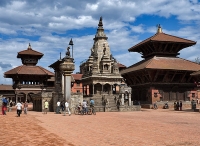
Also known as the City of Devotees, Bhaktapur lies just 22 miles (35km) east of Kathmandu. The wealth of fabulous architectural showpieces, soaring pagodas, richly ornamented houses, and medieval layout is testament to the period when the city was the capital of the Kathmandu Valley during the 14th and 16th centuries.The whole town is a UNESCO World Heritage Site filled with palaces, temples, statues, and squares, connected by a maze of largely pedestrian streets. The main Durbar Square boasts many architectural attractions, including the Golden Gate, the 15th-century Palace of 55 Windows, and several statues of ancient kings.Taumadhi Square is presided over by the elegant Nyatpola Temple. Sitting atop a five-story platform, Nyatpola is the tallest pagoda temple in the Kathmandu Valley. Bhaktapur is also the centre of traditional pottery and weaving industries in the region.Visiting Bhaktapur is like stepping back in time, with its largely preserved ancient traditions, frequent colourful festivals and a meticulously restored cityscape. Visitors to this magnificent ancient city are required to pay a fairly steep entry fee, after which it's possible to stay in the city for up to a week.
Transport : Bus (45 minutes) or taxi from Kathmandu.
Admission : Foreigners are charged an entrance fee of about NRS 1,500.
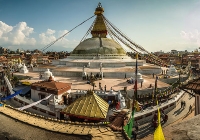
The Boudhanath Stupa is the largest in the Kathmandu Valley, standing about 131 feet (40m) tall. It's one of the biggest and most important Buddhist stupas in the world. The all-seeing red, white, and blue eyes of the Buddha are painted on all four sides of the stupa, similar to Swayambhunath.Hundreds of fluttering prayer flags, prayer wheels, and small images of the Buddha surround the building. It is central to the Tibetan culture in Nepal and said to date back 500 years, although there is some debate about the exact date of construction.The Boudhanath Stupa is on the ancient trade route from Tibet to Nepal, and Tibetan pilgrims and merchants have been praying at the site for centuries. The influx of Tibetan refuges has led to more than 50 Tibetan monasteries built around the stupa. It's a UNESCO World Heritage Site and one of the most popular tourist attractions in Kathmandu.It is conveniently close to the city, located just 6.8 miles (11km) outside Kathmandu. Buddhist festivals cause a flurry of activity at the stupa, with thousands of pilgrims joining together in the sacred rituals, such as the Tibetan New Year, or Lhosar, in February every year.
Admission : NPR 250 for adults (waived if you are staying at one of the hotels located near the stupa).
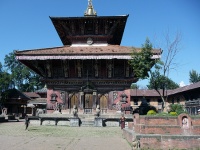
Dedicated to the Hindu god Vishnu, Changu Narayan Temple sits on a ridge overlooking the Kathmandu Valley. Believed to be 1,600 years old, it's one of the oldest and most impressive examples of pagoda architecture in Nepal.The complex is a UNESCO World Heritage Site known for its incredible woodcarvings, metal inscriptions, and stone statues adorning the courtyard, all dating from between the 5th and 13th centuries. The complex is located on a high hilltop and surrounded by a forest and a small village called Changu.The views from the top are spectacular on a clear day and there are various shrines and sculptures in the extensive temple grounds, as well as vendors and artisans who offer comparatively well-priced and crafted souvenirs.The temple is a deservedly popular attraction but its location just outside of the city ensures it's not too crowded. There is an information centre at the entrance to Changu where tickets are issued and information about the temple and wider area is available. Those wanting refreshments will find a number of cafes and restaurants near the temple.
Address : Nine miles (15km) from Kathmandu
Admission : NPR 300
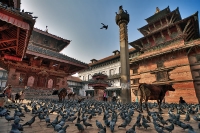
Protected as a UNESCO World Heritage Site, Durbar Square is the religious and social heart of Kathmandu's old city. Built between the 12th and 18th centuries by the ancient kings of Nepal, it's a complex of palaces, temples, shrines, statues, and courtyards.The square is a queer assortment of the old and the new: elaborately carved architectural features and curving roofs provide shelter for cows and weary tourists. Brahman priests and painted sadhus perform rituals and pose for photos, while souvenir sellers and rickshaw drivers compete for attention among the crowds.Stone lions guard the gates to the Old Royal Palace which contains a number of courtyards and houses the Narayanhity Durbar Museum. Set into the palace wall is a 17th-century stone inscription written in 15 languages. It's believed milk will flow from the spout if anyone deciphers the entire inscription.
Opening times : Durbar Square: daily 8am-5pm. Old Royal Palace: Tuesday to Saturday 9:30am-4pm.
Admission : Durbar Square: NPR 1,000. Old Royal Palace and museums: NPR 500.
One of the most sacred Hindu shrines in the world, the UNESCO World Heritage Site of Pashupatinath is one of the major temples devoted to Lord Shiva on the Indian subcontinent. It attracts thousands of Hindu pilgrims each year, with Shiva being the patron deity of Nepal.The Temple of Pashupatinath is renowned for its beautiful architecture and stands on the banks of the holy Bagmati River, a tributary of the Ganges. Other temples, shrines, statues, and pagods surrounded this large temple complex, which can take some time to explore. The temple buildings are closed to non-Hindu visitors but the grounds are not.Shiva devotees and holy Hindi ascetics called sadhus roam the complex in great numbers, meditating and praying on the steps throughout the temple. One of the richest temples in Nepal, it received a great deal of wealth from kings and aristocrats in devotion to the god.The complex is also home to Kathmandu's funeral ghats, a series of cremation platforms spread along the river where the bodies of Hindus are burnt and the ashes scattered into the holy river. Tourists should be respectful when witnessing these cremation ceremonies and particularly cautious about taking photographs.
Address : Three miles (5km) east of Kathmandu, in Deopatan
Admission : NPR 1,000
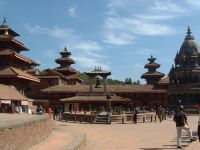
Officially called Lalitpur Metropolitan City, Patan is one of the three royal cities in the Kathmandu Valley. It has a rich cultural heritage and is known for its fine crafts, evident in the elaborate architecture, stone carvings, and metal statues found all over the city.Patan is actually one of the biggest cities in Nepal, with historic attractions mostly located near Durbar Square and best explored on foot. Patan Durbar Square is a good place to see beautiful examples of palaces, temples, and shrines, and stunning stone carvings of the Sundari Courtyards.The entire city of Patan was designated a UNESCO World Heritage Site in 1979 and is a centre of both Buddhist and Hindu culture in Nepal. Patan is home to more than 1,200 monuments, so tourists are spoiled for choice.One of the most stunning sites is the Krishna Mandir, a stone temple with magnificent friezes built in the 16th century. Other amazing temples include the Mahaboudha Temple, the Rudravarna Mahavihar, the Machchhendranath Temple, the Golden Temple, and the Kumbheshwar Temple. The Patan Museum is also a very popular tourist attraction.
Admission : Patan Durbar Square NPR 500, Patan Museum NPR 250
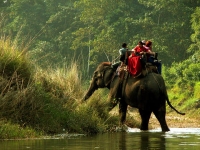
Of the 14 national parks and reserves in Nepal, the Royal Chitwan National Park is the oldest and most popular safari destination for visitors. Situated in the subtropical Tarai lowlands, the jungle is home to endangered animals such as the one-horned rhinoceros and the royal Bengal tiger.Other animals include leopards, wild elephants, Indian bison, sloth bears, crocodiles, pythons, monitor lizards, pangolins, and over 400 species of birds. The terrain is mostly flat, consisting of dense jungle, marsh, and grassland. There's no guarantee of good game sightings, so it is best to spend at least two days in the park.Elephant safaris are the most popular way to explore the park. Jeep safaris, guided walks, overnight jungle expeditions, and canoe trips are also available. There is a wide choice of accommodation, ranging from luxury camps or hotels within the park to budget options on the outskirts.The best place to look for budget accommodation is Sauraha, becoming something of a tourist centre with hotels, restaurants, bars, travel agents, money changing facilities, shops, and even internet cafes. The town has a beautiful setting, sitting on the banks of a wide river in the jungle.
Website : www.chitwannationalpark.gov.np
Transport : The Royal Chitwan National Park is an excursion from Kathmandu or Pokhara. Its linked by public bus, tourist coach, and air, and is a seven-hour bus journey from Kathmandu or six hours by bus from Pokhara.
Admission : Daily park entry permit: NPR 1,500 (extra charges apply for those wishing to fish, canoe, camp, or go on safaris).
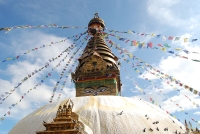
Colourful fluttering prayer flags adorns the golden spire of the 5th-century Swayambhu Stupa. It crowns a hill overlooking the Kathmandu Valley and offers fantastic views over the capital city of Kathmandu.The Swayambhunath Stupa is one of the most recognisable symbols in Nepal, with the painted eyes of the Buddha watching all those who ascend the worn stone steps. A UNESCO World Heritage Site, it is one of the holiest Buddhist sites in Nepal and is at the source of the valley's mythical beginning.Legend has it that the history of the valley began with the draining of an ancient lake by an Enlightened Being, when a lotus flower was transformed into the hill and the shining light became the stupa itself.Also called the Monkey Temple, swarms of pilgrims and red-clad monks circle the complex, spinning the prayer wheels while scores of monkeys which give the temple its nickname prance about in irreverent troupes.The temple complex is scattered with shrines and statues of Buddhist and Hindu deities, and the assortment of pilgrims from both faiths characterises the country's unique religious harmony. Visitors should note that although they are often adorable and entertaining, the monkeys can sometimes become aggressive if you have something they want.
Admission : NPR 200

Travel Guide powered by Word Travels, copyright © 2023 Globe Media Ltd. By its very nature information in this travel guide is subject to change at short notice and travellers are urged to verify information on which they're relying with the relevant authorities. Neither Globe Media Ltd nor Travel Vogue can accept any responsibility for any loss or inconvenience to any person as a result of information contained above.